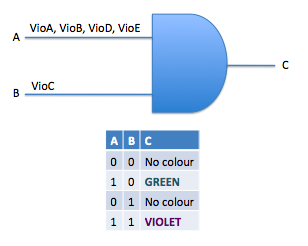Team:Cambridge/Future
From 2009.igem.org
Categories :
Project :
-
Overview
Sensitivity Tuner
--- Characterisation
--- Modelling
Colour Generators
--- Carotenoids (Orange/Red)
--- Melanin (Brown)
--- Violacein (Purple/Green)
The Future
Safety
Notebook :
Team Logistics :
The Future
Synthetic biology is an exciting new area of science, and continues to rapidly develop and change. It has the potential for use in a wide variety of areas, and new technologies. We considered these issues throughout the summer, and took part in workshops which explored the potential for our devices in the future.
The Near Future
Applications of the sensitivity tuner and colour output
We believe that our kits of sensitivity tuners and colour-generating devices can be applied directly to environmental sensing. For proof of concept, we attached our sensitivity tuners to the arabinose sensor. However there are so many different sensors in the registry (and in the natural world!) which could benefit from this device. The registry already contains promoters for lead, arsenic and other pollutants, and we would like to undertake more work to show that the sensitivity tuners are compatible with these promoters. The use of the sensitivity tuner would confer on these promoters the ability to distinguish more accurately distinct pollutant levels, and the pigment output would allow them to be used without expensive equpient, in places where this may be impractical or too costly. We looked at the potential for this system in helping countries such as Bangladesh, which has severe problems with arsenic pollution, in areas where expensive sensor devices are unavailable.
Expanding our selection of sensitivity tuners and pigment-producing operons
The 2009 Cambridge iGEM team has generated two kits of parts - a kit of Sensitivity Tuners, and a kit of Colour Generators. Each could be expanded - more phage activators and phage promoters could be added to the Registry, and other pigments of bacterial origin could be made into biobricks. We hope that we have illustrated a standard method to characterize Sensitivity Tuners and to design and describe new pigments that future iGEM teams can reproduce.
Manipulation of Pigment operons
The carotenoid and violacein operons are able to produce more than one pigment each. This gives future iGEM teams the opportunity to manipulate these operons. For example, with the carotenoid system, there is the potential to change red to orange. Inducible colour change has particular application to our dipstick prototype. If the bacteria in each well constitutively expressed orange pigment, this would be an indication that the bacteria were alive. The change from red to orange would be induced by the pollutant. As for violacein, colour logic could be used to detect combinations of pollutants:
The Distant Future - potential for colour
In the Colours Future workshop (organised by Daisy Ginsburg and James King from the Royal College of Art) we concentrated on our various pigments, considering how the ability to exploit pigments from the natural world--not just from bacteria, but from plants and animals--might affect the world we live in. What if pigments are used as reporters for applications beyond bacterial biosensors? What if we harnessed natural pigments and used them to artificially colour the world, even ourselves? What ramifications might these leaps and bounds have? We divided these considerations into four main groups:
Products
Both bacterial pigments and synthetic biology in general has the potential to be used to create many different products and technologies. Crispian, Alan and Caitlin explored the use of synthetic biology in a range of products from childrens toys to commencial food-colouring. This would create issues of property and patents; if the biobrick for colour is in an open source registry, would this create problems for people hopeing to patent a certain colour, or a gene for a colour? Megan and Mike took this to an extreme with a sketch from a world where the colour orange was patented, and it's use under strict control.
Services
Along with new technologies, comes the creation of new services, providing jobs that previously did not exist. Working with synthetic biology tools and products could become an industry in itself, with a unique skill-set. As the design of devices reaches higher levels of abstraction, the concept becomes more available for different industries to use, and provides new ways to consider the workings in biological cells. In view of our colours, we imagined a future where pigments from the natural world were in high demand, creating the job of 'colour-hunter', people looking for the brightest and best colours, from the smallest and most easily reproducible genetic systems.
Groups
New technologies and ways of thinking also have a social effect. Products create gaps between the have and have-nots, while changes in employment patterns and sectors can create a need for new skill-sets. The field of synthetic biology is becoming more widely recognised as a group (and a degree title!) that more and more people are becoming part of. Shuna, Siming and Viv looked at how colours could effect social groupings and cultures, especially given that different cultures will have very different associations for each colour.
Laws
Synthetic biology, and the parts registry is open source, and yet the world of products and services relies heavily on ownership and property rights. This creates issues of property and patents; which may require new laws. Megan, Mike, and Tom took this to an extreme with a sketch from a world where the colour orange was patented, and it's use under strict control (much to the anger of coutries whose national flags contain the colour, as well as a certain well known mobile phone provider!)
 "
"
